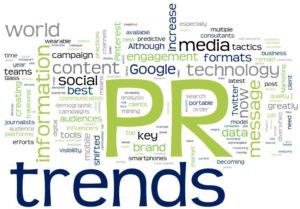
By Aaron Blank, President of PRGN & CEO of The Fearey Group
Public relations is thriving – and evolving in exciting ways. It’s a great time to be in the business.
At its core, our work is unchanging: actively pursuing relationships – shaping them, building them and maintaining them. That will always be front and center. But other aspects of our profession are developing or expanding.
Here are the trends I’m watching:
1. Demand for data. The push to link PR to overall business objectives continues, pushing us to develop more and more meaningful metrics to measure PR performance and impact on operations. Measurement has always been a challenge for PR practitioners, but it’s finally getting easier. Now we can measure article clicks, sentiment and tone much more easily. For example, we can automatically measure links back to websites to show how our work drives traffic or supports lead generation.
2. Application of search. Search now plays a critical role in forming PR campaigns. We can use SEO keywords to discover trends, identify potential news items and understand the questions, issues, products and service people are looking for. This makes it faster and easier to target our work to consumer insights.
3. Optimized press releases. People have been saying that the press release is dead for years. And the truth is, the old version of the release is. Gone are the days when we wrote a release and expected the media to pick it up. Today’s optimized press release is content – content that enables us to tell our own story and manage our message. Still a great way to update reporters on organizational news, modern releases posted on our own sites support organic and paid search, and create opportunities to link back to additional content in our ecosystem. We can use them as catalysts for identifying issues or events to leverage and serve as the foundational content for larger campaigns involving earned, owned and paid media.
4. Investment in AI. It’s fun to see how artificial intelligence (AI) is starting to play a role in the industry. For instance, a new tool called SignalAI uses AI to make it easier to track numerous companies, people, events, trends – and analyze that information to support decision-making and inform campaigns. And new AI transcription services such as REV make speech-to-text faster and cheaper – some are even tailored to specialized industry sectors like healthcare or engineering. These tools enhance our skill sets and enable us to deliver better service to our clients so our teams can focus on more strategic pursuits.
5. Continued value of writing. No matter what, at the end of the day, we all have to write. Whether it’s a tweet, an email, a public statement or back-end website items that influence a reputation, we have to continue to perfect the editorial process. It’s vital.
PR has never been more valuable and more relevant. Responding to these trends empowers us to continue to produce high-quality work that shapes debates, changes behaviors and supports business operations. Investing in building entrusting relationships will always be the best marketing tactic of them all.
The Feaery Group is our partner agency in Seattle, USA. Article originally published at PRGN.com









